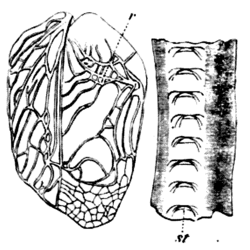of the Locustidæ is so loud that it can be heard during the night at the distance of a mile;[1] and that made by certain species is not unmusical even to the human ear, so that the Indians on the Amazons keep them in wicker cages. All observers agree that the sounds serve either to call or excite the mute females. With respect to the migratory locusts of Russia, Körte has given[2] an interesting case of selection by the female of a male. The males of this species (Pachytylus migratorius) whilst coupled with the female stridulate from anger or jealousy, if approached by other males. The house-cricket when surprised at night uses its voice to warn its fellows.[3]

Right-hand figure, under side of part of a wing-nervure, much magnified, showing the teeth, st.
Left-hand figure, upper surface of wing-cover, with the projecting, smooth nervure, r, across which the teeth (st) are scraped.In North America the Katy-did (Platyphyllum concavum, one of the Locustidæ) is described[4] as mounting on the upper branches of a tree, and in the evening beginning "his noisy babble, while rival notes issue from the neighbouring trees, and the groves resound with the call of Katy-did-she-did the live-long night." Mr. Bates, in speaking of the European field-cricket (one of the Achetidæ), says, "the male has been observed to place himself in the evening at the entrance of his burrow, and stridulate until a female approaches, when the louder notes are succeeded by a more subdued tone, whilst the successful musician caresses with his antennæ the mate he has won."[5] Dr. Scudder was able to excite one of these insects to answer him, by rubbing on a file with a quill.[6] In both sexes a remarkable auditory apparatus has been discovered by von Siebold, situated in the front legs.[7]
- ↑ L. Guilding, 'Transact. of the Linn. Soc.' vol. xv. p. 154.
- ↑ I state this on the authority of Köppen, 'Ueber die Heuschrecken in Südrussland,' 1866, p. 32, for I have in vain endeavoured to procure Körte's work.
- ↑ Gilbert White, 'Nat. Hist. of Selborne,' vol. ii. 1825, p. 262.
- ↑ Harris, 'Insects of New England,' 1842, p. 128.
- ↑ 'The Naturalist on the Amazons,' vol. i. 1863, p. 252. Mr. Bates gives a very interesting discussion on the gradations in the musical apparatus of the three families. See also Westwood, 'Modern Class.' vol. ii. pp. 445 and 453.
- ↑ 'Proceedings of the Boston Society of Natural History,' vol. xi., April, 1868.
- ↑ 'Nouveau Manuel d'Anat. Comp.' (French translat.), tom. i. 1850, p. 567.
